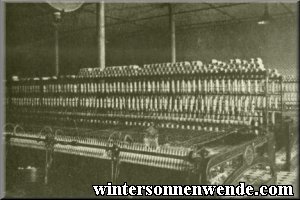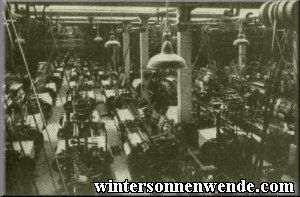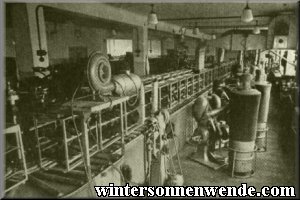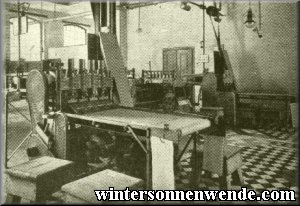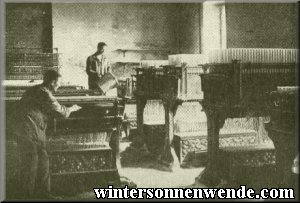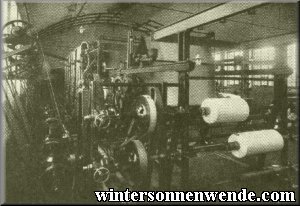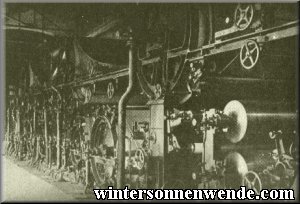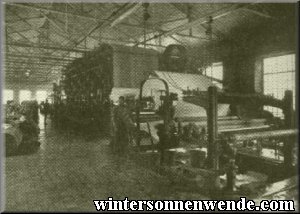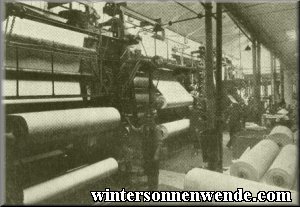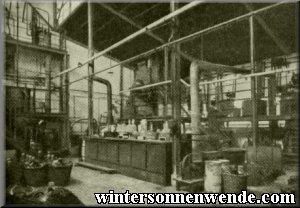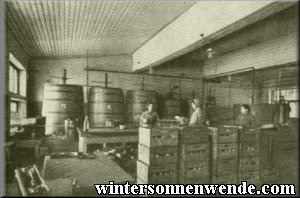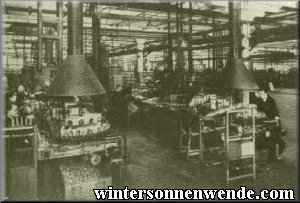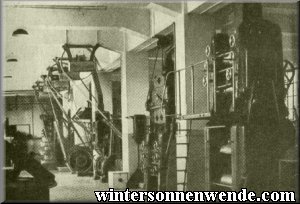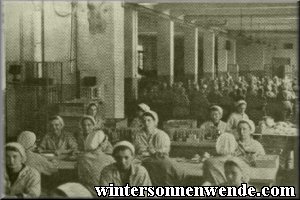 |
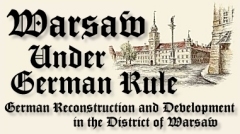 Economic Development in the District of Warsaw
1. The District as Commercial and Industrial Center of the General Government
According to Polish statistics from 1938, the entire former Republic – including the areas now incorporated into the Reich – contained within its borders 9,166 industrial facilities, of which 3,916 are located in the territory of the present-day District of Warsaw. Judging from employment statistics, some 170,000 of the total 302,000 industrial workers – no less than 56% – were employed in the area which is now the District of Warsaw. As well, the headquarters of numerous medium and large firms were located in Warsaw, further enhancing its industrial significance. A natural consequence of this industrial concentration in Warsaw was that almost the entire banking business had located there, with altogether 28 banks, the records of some of which revealed transactions in the billions of zloty. Warsaw was also home to the head offices of almost every major insurance company. In the time after the world war, large modernly-equipped armaments factories were built in the Warsaw Basin, further increasing the area's general industrial activity. Using the corresponding numbers of employees in the present General Government as comparative 1938 baseline statistic, the various branches of industry accounted for the following employment percentages:
The nature of industry in Warsaw can be described as consisting in the main of secondary and finishing activities since, aside from the raw materials for the numerous brickworks, the District harbors no natural resources of its own so that raw materials and semi-finished products for further processing must be imported from elsewhere. An industrial work force has settled in the vicinity of this industrial center, chiefly within Warsaw and its environs. It must be emphasized that there are a great many trained professionals among this work force. An extensive industrial self-administrative apparatus, the Industry and Trade Group with its professional associations and numerous vocational colleges, sees to the training of the young people and strives not only to maintain the current level of training but also to improve present performance. The major banks established in Warsaw are in a position to guarantee the necessary financial basis for an industrial upswing, particularly as capital from the Reich proper will increasingly contribute to the finances of these banks. Growth and development to date have been largely due to the successful implementation of German leadership and influence. The creation of a German upper social stratum and the reorganization of firms along German lines of management is making steady progress and has already had gratifying results. It has become evident in the course of this process that it is quite possible for relatively small numbers of German organizational personnel not only to maintain productivity but also to achieve considerable successes in terms of output as well as cost-effectiveness, even in large companies whose work force and supervisory staff is exclusively Polish. The convenient location of Warsaw at the intersection of north–south and east–west traffic arteries, as well as the well-developed railway network, contribute not a little to Warsaw's growing importance as trading and traffic node. If one then also considers Warsaw's location on the Vistula River (the significance of which is discussed in greater detail elsewhere in this volume) as well as the possibilities offered by the development and regulation of the Vistula and by the city's and river's location relative to the new eastern territories, the future development of industry in the District looks promising indeed, despite the present difficulties resulting from the war. The following is to give a brief synopsis of the main branches of industry in the District. It must, however, be pointed out beforehand that the average level of sophistication clearly bears no comparison with that of the Reich. Certainly there are numerous firms which have excellent organizational and mechanical facilities at their disposal; but these are juxtaposed with a great many small enterprises whose technological level, judged by German standards, cannot be described as anything other than antiquated. With more than 500 facilities, the iron- and metal-processing industry is by far the leader of the industrial activities in the District. In 1938, almost 35,000 workers were employed in this branch of industry. The technological stage of development is particularly varied in this area; besides modern and well-managed firms one will also find such as are not far beyond the manual production stage. Nearly all branches of production are represented in the District of Warsaw's iron- and metal-processing industry. There are iron foundries, factories for the production of small and unsophisticated machinery and gadgets, wire drawing shops, nail factories, factories producing building hardware, tools, household equipment and the like. The electrotechnical industry is also of significance in the District. According to the statistics previously quoted, there were 119 factories in this field, with over 10,000 employees. A considerable portion of this industrial potential remains even when one considers that these statistics of the iron- and metal-processing and electrotechnical industries include many small and insignificant production facilities, that some were destroyed in the war, and that others have since been closed down and dissolved. While Warsaw was not the focal point of the former Polish state as far as the textile industry was concerned – most textile factories were located in Litzmannstadt [now Lodz] – this branch of industry was nevertheless strongly represented in the District. According to the Polish statistics of 1938, there were then
606 clothing production firms
In the footwear industry, approximately 85% of production was from manual labor even before this time. The remaining 15% were produced by medium-sized mechanized footwear factories in Warsaw, all of which were Jewish-owned, and by the shoe factory "Bata" in Chelmek.
In the former Polish state, Warsaw was the heart ot the leather industry. Before the war there had been some 60 good-sized tanneries in the area of the present-day District of Warsaw, approximately 40 of which were Jewish-owned. Following the closure of all Jewish operations, the German administration authorized for continued production only the most efficient tanneries, with a sum total of 40% of the overall pre-war productivity. In 1941, 23 tanneries were still active, with an average total workforce of 600.
In light of the superabundance of paper which used to be the norm in Poland, it is not surprising that there is also an extensive processing industry which, again, is centered largely in Warsaw. For example, the oldest wallpaper factory in the territory of the General Government is located in Warsaw. That Warsaw also has numerous important printing and publishing establishments is a logical consequence of the great economic significance which it also had in the former state of Poland. For one, there is the state printing establishment where bank notes, tax seals, seals and stickers, food stamps and the like are produced. Then there are also the printing establishments of the municipal administration, the Post Office Savings Bank, Silesian Press, and the newspaper publishing house Cracow–Warsaw, where various newspapers, pamphlets, and publications for the Wehrmacht are produced.
The construction materials industry in the District consists of 22 roofing felt factories which altogether have an annual production capacity of 17.2 million sq.m. of roofing and insulation materials. And finally, the wood-processing industry must also be mentioned. There are about 60 wood processing plants in the District, including some very efficient plants which produce quality furniture, household equipment, and the like. It will be possible to further increase the quality of these products once retraining and education programs have effected the more pronounced representation of German tastes.
Even though this discussion has been largely restricted to matters of industrial production, to complete the picture it is necessary to point out that Warsaw was also the chief commercial center of Poland, with great significance for wholesale, import and export trade, and was the site of the state's largest commercial enterprises. Commercial activity had mostly been in the hands of the Jews. Here too, as in the case of industry, great changes have been made: the Jews have been almost completely removed from the economy. Their positions have been filled by native persons and by Poles evacuated from the new districts of the Reich, which has enabled a smooth exchange of manpower without any interruption of the economic process. It goes without saying that the current economic situation does not give a realistic picture of trade competitiveness, but it may be seen that in Warsaw in particular, trade has always been very strong and has retained its importance to this day. The connection (to be discussed in greater detail later) with the seaports of the Baltic, particularly with Danzig and Königsberg [now Kaliningrad] and with the eastern regions extending to the Black Sea, has always been upheld in Warsaw, which means that the acquisition of these great eastern regions is economically most promising for the future. There are approximately 35,000 commercial enterprises in the District at this time. Besides industry and trade, crafts have always been of special significance in Warsaw. It is historically documented that German cultural influence on craftsmanship in particular was very strong in the past centuries. For example, the Warsaw guild records prove that numerous German master artisans, following in the footsteps of the Saxon architects, came to Warsaw in the 18th century. The number of craft workshops presently stands at about 20,000. Since the workshops have on average 2.3 workmen, the number of employees may be estimated at some 45,000. The importance of manual craftsmanship has already been indicated by the fact that these craftsmen account for 85% of the total production of shoes. Their work can frequently be considered very high quality and attracts special attention at the German trade fairs time and again. The same can be said of the tailoring trade and of joinery and carpentry. High quality bakery, butchery, and cake and pastry establishments reflect the demand made on them by the relatively high standard of living in Warsaw. An elaborate and thorough guild system and well-managed vocational colleges have contributed greatly to the merits of craftsmanship in Warsaw. Under German leadership, crafts establishments were gathered into a tight organization with the responsibility to perform quality self-control and particularly to see to the education and training of the next generation of craftsmen. The importance of industry, commerce and craftsmanship is best shown by the fact that in 1940 and 1941, the District of Warsaw alone raised as much in federal and municipal taxes as the Districts of Cracow, Lublin and Radom put together. At the same time this is the best justification of the reconstruction and development work that has gone toward these areas of the economy, as the bulk of this tax revenue came from these three economic sectors.
 2. Warsaw's Economic Relations With its Neighboring Regions and the Hanseatic Towns Warsaw's great economic significance is shown not only by the District's role as very strong economic focal point of the General Government, but also by the fact that its economic relations extend far beyond the General Government's borders.1 Of primary importance in this respect is the old Hanseatic city of Danzig, which has always had particularly strong trade relations with Warsaw. As early as the 13th century, Warsaw engaged in active trading with Danzig via the Vistula, with grain, wood, pitch and tar being the chief exports. According to an old chronicle, the export of Polish grain via Danzig in 1618 amounted to 128,789 laczty, which is an old Polish measure approximately equivalent to 2.5 tons. Danzig also had strong economic ties to Congressional Poland of days gone by, as this was its natural hinterland. This close interrelationship of economic interests grew even stronger particularly during those years in which Danzig was split off from the Reich by the dictates of the Treaty of Versailles. The Polish Republic certainly did everything it could to force the German city of Danzig to its knees, especially by constructing the rival port of Gdingen [now Gdynia] which was intended to throttle Danzig's shipping activities; but Danzig, to secure its existence, nevertheless cultivated strong ties to the Polish hinterland, even though economic interactions often had to be carried out "under cover". Fluency in the Polish language was the rule in Danzig's merchant circles, and this, together with thorough familiarity with the requirements of the Polish state, put Danzig's economy – a product of centuries of experience – in a position to always have a clear overview of the economic conditions in Poland, to enter the picture at the right place and at the right time, and thus to preserve its own existence. When Danzig returned to the Reich and the Gau of Danzig-West Prussia was established, it was therefore only natural that Danzig and the General Government, which had come into existence at the same time, should take up close relations in order to further consolidate old economic ties. Leading men of the Danzig economy, headed by the Reich Governor and the President of the Danzig Chamber of Industry and Commerce, were the first to approach Warsaw, where these first attempts at economic partnership were received with enthusiasm. The repeated visits of Danzig economic leaders to Warsaw and Cracow were followed by return visits by the Governor of the District of Warsaw and the President of the General Government's Economic Department, among others. For as long as the General Government has been in existence, Warsaw has placed special emphasis on maintaining very close contacts with Danzig. One of the first outcomes of these relations was that German commercial enterprises were introduced to and established in the District of Warsaw with the assistance of the Danzig-West Prussian Chamber of Industry and Commerce. No less than 24 firms, all but two from Danzig-West Prussia, have been established in the District of Warsaw. Their introduction has been uniformly worthwhile. Each county precinct was assigned one leading German firm which has contributed greatly to the revival of the economy and has served Polish businessmen as a model of German management. These firms have devoted themselves most commendably to the important harvesting issues, acting chiefly as agents of produce exchange. Relations with Danzig-West Prussia have gradually intensified further; two major textile firms from Danzig have leased the facilities of "Wola" and "Broun & Rowinski", which had been placed in trust. The Danzig merchant Dietrich Dirksen, who has since fallen on the field of honor, was the first to establish a German business house in Warsaw. Co-operation with Danzig-West Prussia has been so successful because the Danzig Chamber of Industry and Commerce and the leading men of the Gau of Danzig-West Prussia stand behind the firms introduced to the General Government and support them in every way possible. The General Government and particularly the District of Warsaw also maintain close relations with the neighboring Gau of East Prussia. This too is only natural, as East Prussia shares a 150 km. border with Warsaw and as a result has many interests in common with the General Government. Attempts to introduce firms from East Prussia to the District of Warsaw have, unfortunately, had only limited success to date. The General Government nevertheless continues to strive to render future relations with this region more lively. For this reason the General Government and especially the District of Warsaw have always taken a most active part in the Eastern Trade Fair in Königsberg. Closer ties between the General Government and East Prussia are all the more desirable as the common border between the two has been further extended by the recent creation of the region of Bialystok. The District has also established extensive economic relations with Berlin and the Hanseatic cities of Hamburg and Bremen. Initially it may seem surprising that the Hanseatic towns maintain economic relations with Warsaw; but this is easily explained. Up to the outbreak of the present war, Hamburg and Bremen were focused mainly on shipping. Their trading was conducted via the sea, with destinations as distant as Australia or Japan. All these trading routes are presently cut off. It was thus only natural for the Hanseatic merchant spirit to look around for new markets. The General Government, being the first newly opened economic region of the German East, was a target area of especial significance and well-known Hamburg firms were quick to establish trade relations. The firm of Illies & Co., which had previously traded mainly with East Asia, has transferred a great deal of its commercial activities to the territory of the General Government, and has been extraordinarily successful. It may be assumed that after the war, even when the Atlantic trade routes are again available and the world's oceans will be open especially to the German merchants, Hamburg and Bremen will not abandon the new relations they have taken up with the East during this war, for the vast newly-open former Soviet regions which are now part of Germany's sphere of influence offer great possibilities for the future. Warsaw will always be of especial importance as a bridge to the East which, by virtue of these events, has in a sense come closer and grown more accessible. It is thus quite understandable that even now, during the war, major firms of the Reich are already eager to establish a firm foothold in Warsaw in order to make the economic resources of the East available to German interests in greater measure at some future date.

1For details, see Grundmann op. cit., p. 33. ...back...
|





